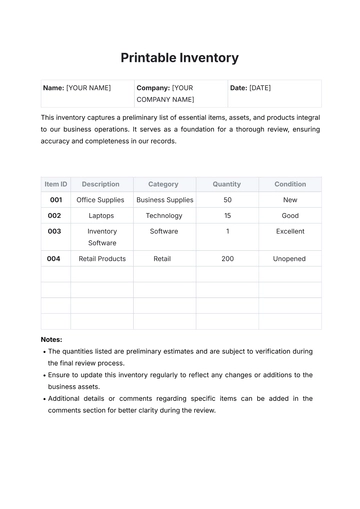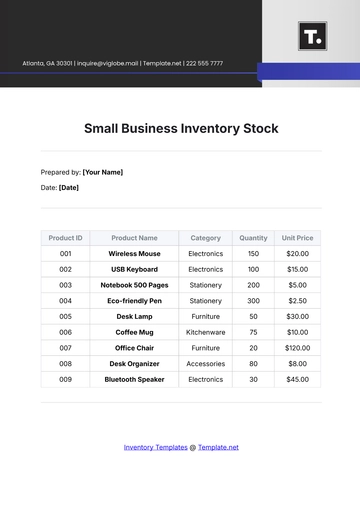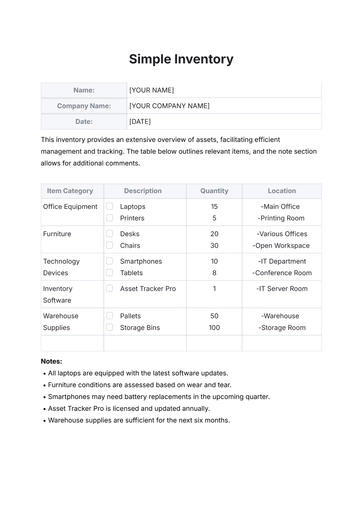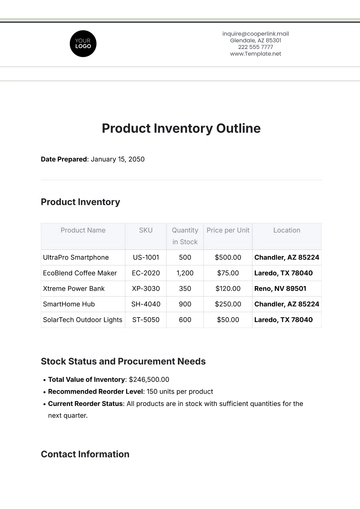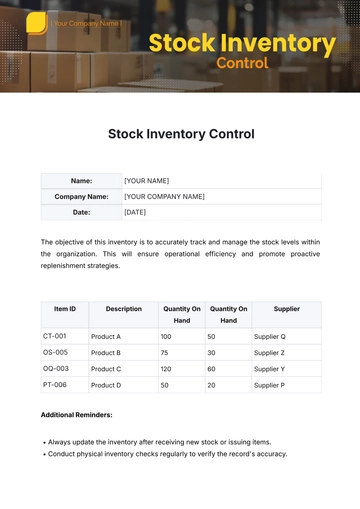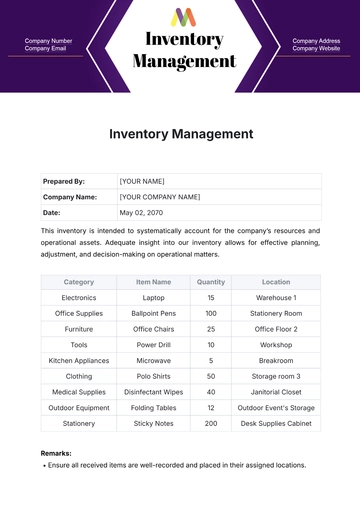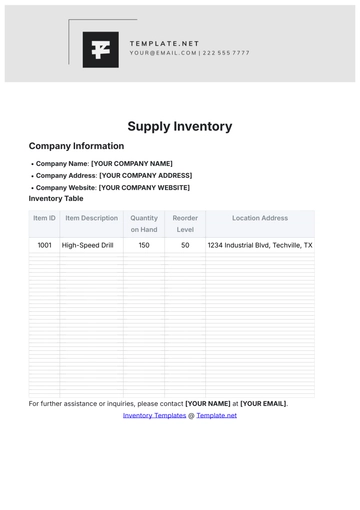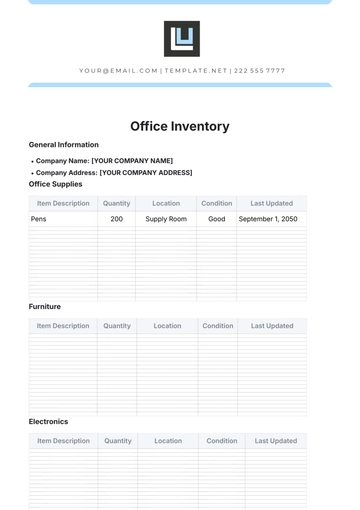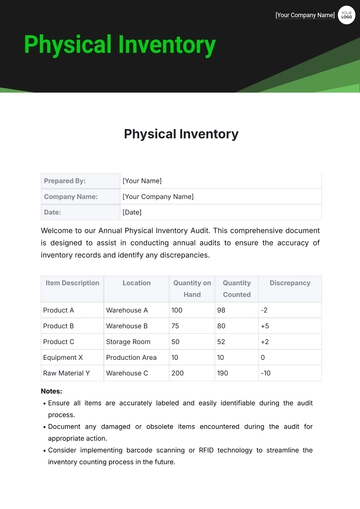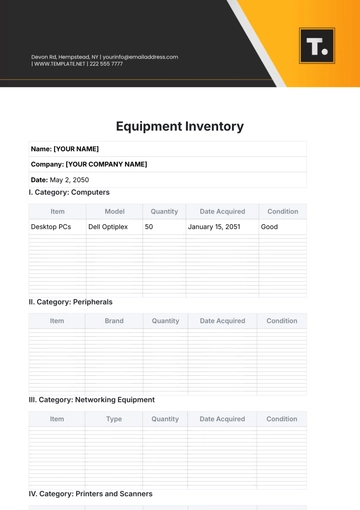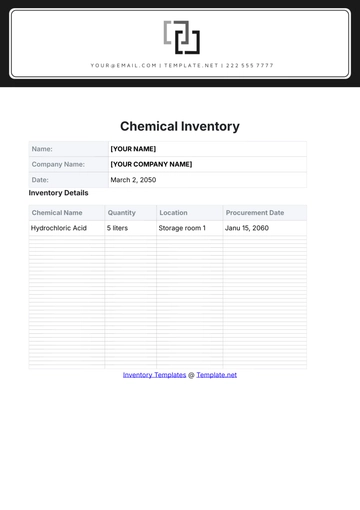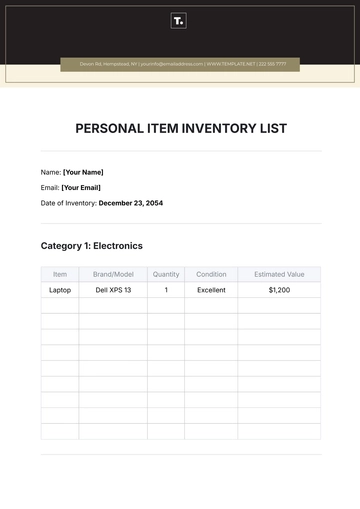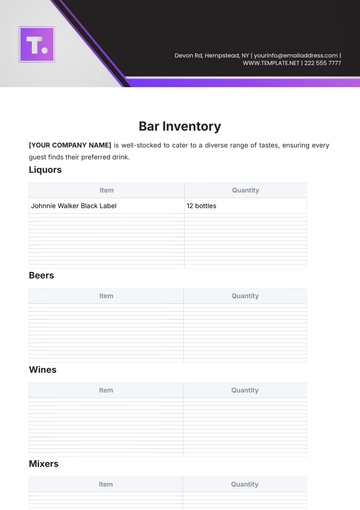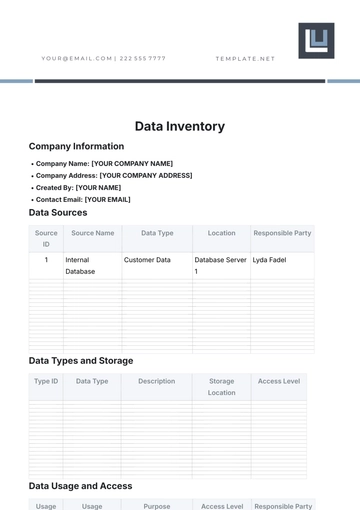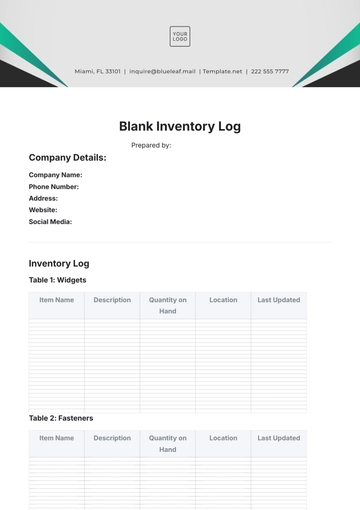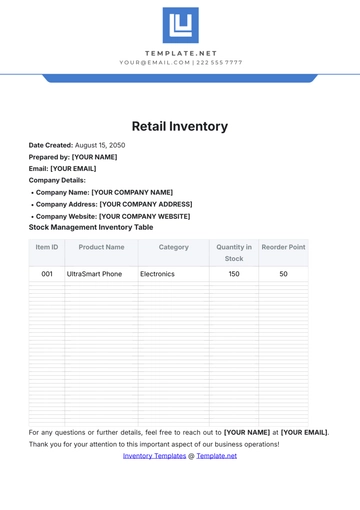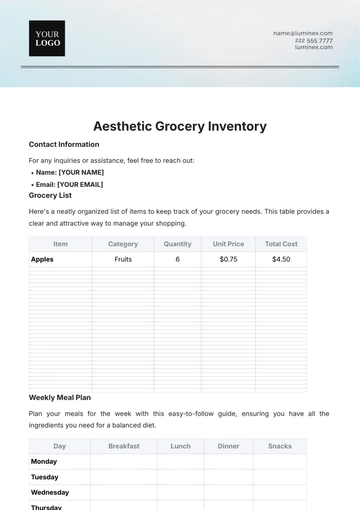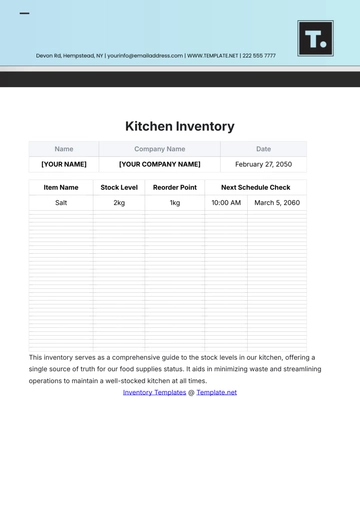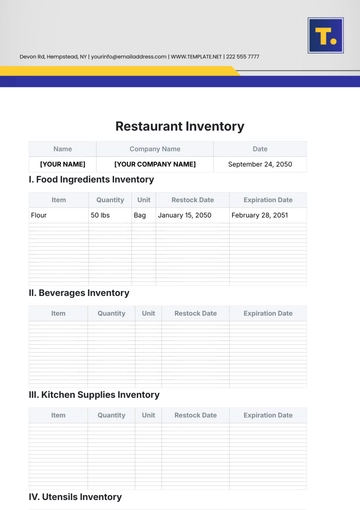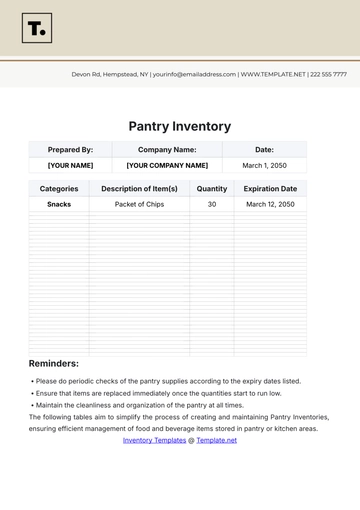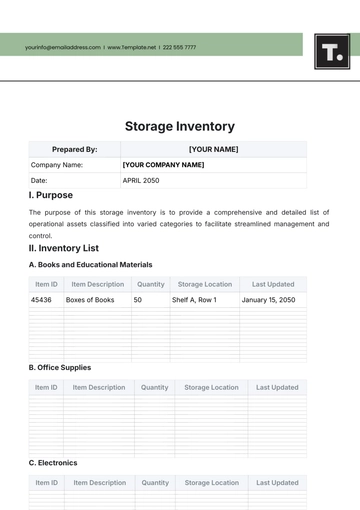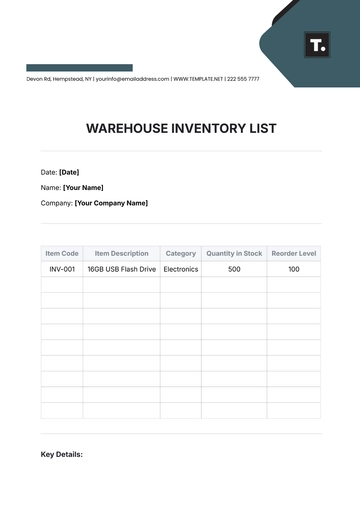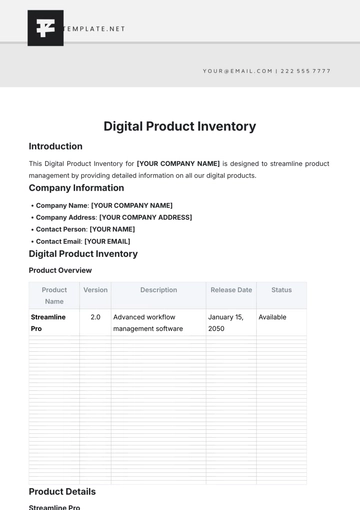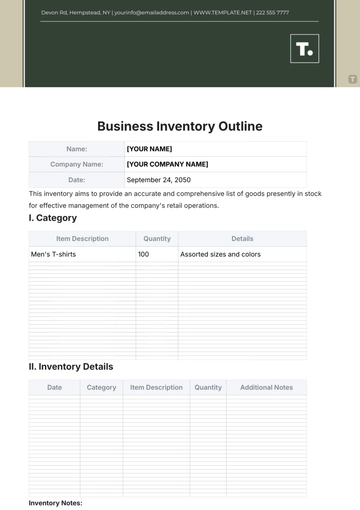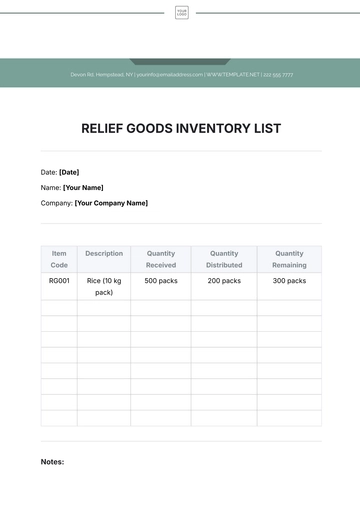Free Church Inventory SOP

I. Introduction
The purpose of this Church Inventory SOP is to ensure efficient inventory management and accountability at [Your Company Name]. Proper inventory management is crucial for maintaining the resources necessary for the smooth operation of our church activities and services.
A. Objectives
Efficiency: To streamline the process of inventory management, ensuring all items are accounted for and accessible when needed.
Accuracy: To maintain accurate records of all inventory items, reducing the risk of loss or misplacement.
Accountability: To establish clear responsibilities for inventory management, ensuring all staff and volunteers understand their roles.
B. Scope
This SOP applies to all staff members and volunteers involved in the management, use, and maintenance of church inventory at [Your Company Name]. It covers all aspects of inventory management, including acquisition, storage, usage, and disposal.
II. Inventory Acquisition
A. Request Process
The following table outlines the steps involved in the inventory acquisition request process:
No. | Step | Description |
|---|---|---|
1 | Identify Need | Determine the need for new inventory items. |
2 | Submit Request | Submit a formal request for the needed items. |
3 | Approval | Obtain approval from the designated authority. |
4 | Purchase | Proceed with the purchase of approved items. |
5 | Documentation | Record details of the acquired items. |
Identify Need: The first step is to identify the need for new inventory items. This involves assessing current inventory levels and determining if additional items are required to support church activities.
Submit Request: Once a need is identified, a formal request must be submitted. This request should include details of the items needed, the quantity required, and the justification for the acquisition.
Approval: The request must then be reviewed and approved by the designated authority. Approval is necessary to ensure that all acquisitions are justified and within budget.
Purchase: After receiving approval, the purchase of the approved items can proceed. It is important to follow the church's purchasing policies and procedures to ensure proper documentation and accountability.
Documentation: Finally, details of the acquired items must be recorded. This includes updating the inventory records with information about the items, such as their description, quantity, cost, and date of acquisition.
B. Vendor Management
Vendor Selection: Select vendors based on their reliability, quality of products, and pricing. It is important to establish relationships with multiple vendors to ensure competitive pricing and availability.
Vendor Evaluation: Regularly evaluate vendors based on their performance. This includes assessing the quality of their products, delivery times, and customer service.
Vendor Contracts: Establish formal contracts with selected vendors to ensure clear terms and conditions for purchases. These contracts should include details on pricing, delivery times, and return policies.
III. Inventory Storage
A. Storage Guidelines
The following table provides an overview of the storage guidelines for different types of inventory items:
No. | Item Type | Storage Requirements |
|---|---|---|
1 | Perishable Items | Store in a cool, dry place with proper ventilation. |
2 | Non-Perishable Items | Store in a secure, organized area. |
3 | Hazardous Materials | Store in a designated, secure area with appropriate safety measures. |
4 | Office Supplies | Store in labeled bins or shelves for easy access. |
Perishable Items: Perishable items should be stored in a cool, dry place with proper ventilation to prevent spoilage. Regular checks should be conducted to ensure items are still in good condition.
Non-Perishable Items: Non-perishable items should be stored in a secure, organized area to ensure they are easily accessible. Proper labeling and categorization help maintain order and facilitate easy retrieval.
Hazardous Materials: Hazardous materials require special storage conditions to ensure safety. These items should be stored in a designated, secure area with appropriate safety measures in place.
Office Supplies: Office supplies should be stored in labeled bins or shelves for easy access. This ensures that staff and volunteers can quickly find the supplies they need without disrupting operations.
B. Inventory Organization
Categorization: Organize inventory items into categories based on their type and usage. This helps in maintaining an organized storage area and facilitates easy retrieval of items.
Labeling: Clearly label all inventory items with relevant information, including their description, quantity, and storage location. This ensures that items can be easily identified and tracked.
Shelving: Use appropriate shelving units to store inventory items. Ensure that shelves are sturdy and capable of supporting the weight of the items being stored.
Accessibility: Arrange inventory items in a manner that allows easy access. Frequently used items should be stored in easily accessible locations, while less frequently used items can be stored in higher or lower shelves.
IV. Inventory Usage
A. Usage Documentation
The following table outlines the steps involved in documenting inventory usage:
No. | Step | Description |
|---|---|---|
1 | Request Usage | Submit a request for the use of inventory items. |
2 | Approve Usage | Obtain approval for the requested usage. |
3 | Record Usage | Document the details of the used items. |
4 | Update Inventory | Update the inventory records to reflect usage. |
Request Usage: The first step is to submit a request for the use of inventory items. This request should include details of the items needed, the quantity required, and the purpose of the usage.
Approve Usage: The request must then be reviewed and approved by the designated authority. Approval is necessary to ensure that the usage is justified and within budget.
Record Usage: After receiving approval, the details of the used items must be documented. This includes recording information such as the description, quantity, and date of usage.
Update Inventory: Finally, the inventory records must be updated to reflect the usage. This ensures that the inventory levels are accurate and up-to-date.
B. Accountability
Assign Responsibility: Assign responsibility for inventory usage to specific staff members or volunteers. This ensures that there is clear accountability for the use of inventory items.
Monitor Usage: Regularly monitor the usage of inventory items to ensure that they are being used responsibly and efficiently. This includes conducting periodic audits and reviews.
Report Misuse: Establish a process for reporting any misuse or discrepancies in inventory usage. This helps in identifying and addressing any issues promptly.
Review Procedures: Regularly review the procedures for inventory usage to ensure they are effective and up-to-date. This includes making any necessary adjustments to improve efficiency and accountability.
V. Inventory Disposal
A. Disposal Guidelines
The following table provides an overview of the disposal guidelines for different types of inventory items:
No. | Item Type | Disposal Method |
|---|---|---|
1 | Perishable Items | Dispose of through composting or waste management services. |
2 | Non-Perishable Items | Donate, recycle, or dispose of through waste management services. |
3 | Hazardous Materials | Dispose of through certified hazardous waste disposal services. |
4 | Electronic Equipment | Recycle through certified electronic waste recyclers. |
Perishable Items: Perishable items should be disposed of through composting or waste management services. This helps in minimizing waste and promoting environmental sustainability.
Non-Perishable Items: Non-perishable items can be donated, recycled, or disposed of through waste management services. Donating usable items to charitable organizations helps in supporting those in need.
Hazardous Materials: Hazardous materials require special disposal methods to ensure safety. These items should be disposed of through certified hazardous waste disposal services.
Electronic Equipment: Electronic equipment should be recycled through certified electronic waste recyclers. This helps in reducing electronic waste and promoting environmental sustainability.
B. Documentation
Record Disposal: Document the details of all disposed inventory items. This includes recording information such as the description, quantity, and disposal method.
Update Inventory: Update the inventory records to reflect the disposal of items. This ensures that the inventory levels are accurate and up-to-date.
Review Disposal Records: Regularly review the disposal records to ensure they are accurate and complete. This helps in maintaining accountability and transparency.
Audit Disposal Procedures: Conduct periodic audits of the disposal procedures to ensure they are effective and compliant with relevant regulations.
VI. Inventory Audits
A. Audit Procedures
The following table outlines the steps involved in conducting an inventory audit:
No. | Step | Description |
|---|---|---|
1 | Plan Audit | Develop an audit plan, including the scope and schedule. |
2 | Conduct Physical Count | Perform a physical count of all inventory items. |
3 | Compare Records | Compare the physical count with inventory records. |
4 | Identify Discrepancies | Identify and investigate any discrepancies. |
5 | Update Records | Update the inventory records to reflect the audit results. |
Plan Audit: The first step is to develop an audit plan. This plan should include the scope of the audit, the schedule, and the team responsible for conducting the audit.
Conduct Physical Count: Perform a physical count of all inventory items. This involves counting each item and recording the quantities.
Compare Records: Compare the physical count with the inventory records. This helps in identifying any discrepancies between the physical count and the recorded quantities.
Identify Discrepancies: Identify and investigate any discrepancies found during the comparison. This includes determining the cause of the discrepancies and taking corrective action.
Update Records: Finally, update the inventory records to reflect the audit results. This ensures that the inventory levels are accurate and up-to-date.
B. Reporting
Audit Report: Prepare an audit report summarizing the findings of the inventory audit. This report should include details of any discrepancies and the corrective actions taken.
Review Report: Review the audit report with the designated authority. This helps in ensuring that the findings are addressed and any necessary actions are taken.
Implement Recommendations: Implement any recommendations made in the audit report. This includes making any necessary adjustments to inventory procedures and controls.
Follow-Up Audit: Conduct a follow-up audit to ensure that the recommendations have been implemented and the discrepancies have been resolved.
VII. Inventory Security
A. Security Measures
The following table provides an overview of the security measures for protecting inventory items:
No. | Measure | Description |
|---|---|---|
1 | Access Control | Restrict access to inventory storage areas to authorized personnel only. |
2 | Surveillance | Install surveillance cameras to monitor inventory storage areas. |
3 | Alarm Systems | Implement alarm systems to detect unauthorized access. |
4 | Inventory Checks | Conduct regular inventory checks to identify any missing items. |
Access Control: Restrict access to inventory storage areas to authorized personnel only. This helps in preventing unauthorized access and reducing the risk of theft.
Surveillance: Install surveillance cameras to monitor inventory storage areas. This provides a visual record of activities and helps in deterring theft and identifying any suspicious behavior.
Alarm Systems: Implement alarm systems to detect unauthorized access. These systems can alert security personnel and prevent potential theft.
Inventory Checks: Conduct regular inventory checks to identify any missing items. This helps in ensuring that inventory items are accounted for and any discrepancies are promptly addressed.
B. Incident Reporting
Report Theft: Establish a process for reporting any theft or loss of inventory items. This helps in promptly addressing the issue and taking corrective action.
Investigate Incidents: Investigate any reported incidents of theft or loss. This includes determining the cause and taking appropriate measures to prevent future occurrences.
Review Security Measures: Regularly review and update the security measures to ensure they are effective. This includes conducting periodic security assessments and making any necessary adjustments.
Train Staff: Provide training to staff and volunteers on inventory security procedures. This helps in ensuring that everyone understands their role in protecting church inventory.
VIII. Inventory Reporting
A. Report Types
The following table provides an overview of the different types of inventory reports:
No. | Report Type | Description |
|---|---|---|
1 | Inventory Summary | Provides an overview of current inventory levels. |
2 | Usage Report | Details the usage of inventory items over a specified period. |
3 | Discrepancy Report | Highlights any discrepancies between recorded and actual inventory levels. |
4 | Audit Report | Summarizes the findings of inventory audits. |
Inventory Summary: The inventory summary report provides an overview of current inventory levels. This report includes details of all inventory items, their quantities, and their storage locations.
Usage Report: The usage report details the usage of inventory items over a specified period. This report helps in identifying trends in inventory usage and ensuring that items are used responsibly.
Discrepancy Report: The discrepancy report highlights any discrepancies between recorded and actual inventory levels. This report helps in identifying and addressing any issues with inventory accuracy.
Audit Report: The audit report summarizes the findings of inventory audits. This report includes details of any discrepancies found during the audit and the corrective actions taken.
B. Report Review
Regular Review: Regularly review inventory reports to ensure they are accurate and complete. This helps in maintaining accurate inventory records and identifying any issues promptly.
Actionable Insights: Use the information in the reports to make informed decisions about inventory management. This includes identifying areas for improvement and implementing necessary changes.
Stakeholder Communication: Share inventory reports with relevant stakeholders, including church leadership and staff. This helps in ensuring transparency and accountability in inventory management.
IX. Continuous Improvement
A. Evaluation and Feedback
Regular Assessments: Conduct regular assessments of inventory management procedures to identify areas for improvement. This includes evaluating current practices, identifying inefficiencies, and determining the effectiveness of existing protocols.
Gather Feedback: Solicit feedback from staff and volunteers involved in inventory management. Their insights can highlight practical challenges and suggest improvements based on firsthand experience.
Analyze Data: Use inventory reports and audit findings to analyze data and identify trends. This helps in understanding patterns, addressing recurring issues, and making data-driven decisions.
B. Updates and Implementation
Document Changes: Record any changes or updates to inventory management procedures. This ensures that all adjustments are officially documented and can be referenced as needed.
Communicate Updates: Inform all relevant staff and volunteers about changes in inventory procedures. Clear communication ensures everyone is aware of and can adhere to the new guidelines.
Implement Improvements: Put the identified improvements into practice. Monitor the implementation process to ensure the changes are effective and address the identified issues.
C. Training and Development
Regular Training: Provide regular training sessions for staff and volunteers on inventory management procedures. This keeps everyone updated on best practices and any new protocols.
Skill Development: Focus on developing specific skills related to inventory management, such as accurate record-keeping and efficient storage practices. Enhanced skills contribute to more effective inventory management.
Review Training Effectiveness: Evaluate the effectiveness of training programs. Gather feedback from participants and make necessary adjustments to improve the training process.
- 100% Customizable, free editor
- Access 1 Million+ Templates, photo’s & graphics
- Download or share as a template
- Click and replace photos, graphics, text, backgrounds
- Resize, crop, AI write & more
- Access advanced editor
Manage church inventory effectively with the Church Inventory SOP Template conveniently available only here on Template.net! This editable template is also customizable to detail your church’s inventory procedures. The AI Editor Tool assists in creating a precise and comprehensive standard operating procedure, ensuring efficient inventory management and accountability! Access immediately!
